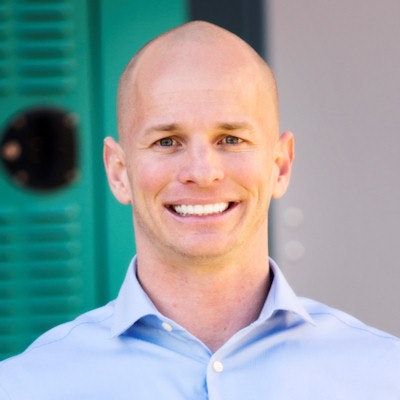
Raise your hand if you had a global pandemic included in your planning for this year? Or how about the resulting shutdown of most dental practices for two to three months? Didn't see that one coming either, right? More personally, how many had vacations canceled; graduations, weddings, or funerals affected; or even the serious illness or death of a loved one, friend, or work associate to grieve?
In a year unlike any other, most of us would be happy to have a fast-forward button we could push and skip ahead to January 2021. We're all ready for 2020 to be over!
 Curtis Marshall.
Curtis Marshall.Well, since we still need to get through October, November, and December before a new year arrives, how can we make sure our dental practices are prepared for a fabulous 2021? No doubt there will be many great ideas shared here on DrBicuspid.com and in many other publications and forums to help you plan ahead. We're honored to add our voice to those of so many other friends in the dental community trying to help dental practices grow.
At Dental Intelligence, we are focused today on helping thousands of dental practices prepare for the new year and beyond. Using the power of actionable data, we believe practices that review and understand these four important metrics have a much better chance of a successful 2021, regardless of what new uncertainties may lie ahead:
- Find out where you are in terms of current production per hour by provider.
- Decide how many hours you want to work next year (not days).
- Make sure you are scheduling to goal, not to fill your schedule.
- Determine whether you reached your current goal because of more hours or because you had more production per hour.
A quick personal example might be helpful in emphasizing why these numbers should be a part of your 2021 goal planning. A close friend of mine had planned to get married in Hawaii in 2020. The invitations were all sent out. A beautiful beach location was identified and reserved -- and then along came COVID-19 and travel restrictions, which meant no more wedding in Hawaii. Did my friend and his fiancée just give up? Happily, no. They pivoted and began working on a new plan. Now they are going to be married in Mexico next year and are looking forward to new options and opportunities that wouldn't have been available to them in Hawaii.
What's the lesson? Instead of being stuck and frustrated by what you can't do, use your creativity and agency to focus on what you can do. These four metrics are all ones you can control and improve upon, regardless of what current or future circumstances might be.
Production per hour by provider
There are many effective ways to think about setting goals in a dental practice. Dental Intelligence employs several methods within our own growth platform. Some recommend a certain amount of production per day, or a dollar amount per day, among other measurements. I personally think that focusing on production per hour by provider is one of the most effective ways to grow your practice.
Here's why: Let's say you have two hygienists in your practice, one who has been working for 10 years and is at the top of her game and the other who just graduated from hygiene school a year ago. Who is likely to produce more per hour? Your more experienced hygienist, of course. The same could be said for one dentist who is fantastic at putting in a crown or another who has a knack for doing two-surface resin MODs. Will these dentists produce different amounts per hour? Yes, and that's great. Dentists are different, and the type of dentistry they perform per hour is also different.
Thus, when dentists say, "I want our practice to produce $10,000 a day," they need to be aware of what they are currently producing per hour by provider. As an example, if Nicole the dentist is working fewer hours, say five hours per day, five days per week, she is going to need to be aware of her production per hour to determine whether she'll need to increase the amount of hours she is treating patients to hit her goal.
Do you know what you are currently producing per hour? How about other clinicians in your practice? One of the best ways to begin preparations for next year is to know exactly how much each provider is currently producing per hour. Dental Intelligence has a number of ways we can help you see these numbers. But regardless of how you figure out your production per hour, make it a priority to do so, and soon.
How many hours do you want to work?
This one may seem obvious, but many don't realize how important it is to track clinical hours, not hours you are in the practice. In other words, don't track every hour you are in the office. Rather, track those hours you are in the chair, treating patients. Back to tracking production per hour by provider, this is why it's so important to add up your clinical hours for the past year before deciding how many hours you want to practice next year. Understanding the difference here will make all the difference. For this challenging year, you'll obviously need to factor in the two to three months you weren't treating patients when planning for your 2021 clinical hour goal.
To summarize, to hit your production per hour goal, you'll need to know how many clinical hours you plan to offer patients next year. That will go a long way toward helping you know where your target is.
Schedule to goal
You might be surprised at how many practices don't follow this simple yet powerful approach when scheduling patients. Often the message given to the front desk is to "fill the schedule!" Without any further direction, staff members go to work trying hard to make sure there are no holes in a day, but there isn't a strategy regarding what kind of patients they should actually be adding to the schedule. Scheduling to goal means you are thinking differently about which patients you are calling to fill openings rather than just calling patients you think will come in. Realistically speaking, it will take a mix here to fill your schedule, but if you are focused on reaching your daily goals, you will change the way you identify which patients you should start with when building a to-call list.
Understand why you succeeded
When you look back on the year, it's important to know which of the following is true:
- I reached my production goal because I worked more hours this year.
- I reached my production goal because I had more production per hour this year than I did last year.
Isn't the goal to produce more in fewer hours? Most would say they're in favor of that approach. If you can produce $10,000 per day in six hours rather than eight hours, who says "no" to that? Thus the importance of knowing the answer to the question above. If your production per hour is the reason you reached or exceeded your goal, that's great news. If not, that's also great to know because this is something you can do something about. Either way, it's important to start by understanding where you are and how you got there before you can really determine where you want to go and how you'll get there.
Even though my friend's wedding plans didn't turn work out as planned, he and his fiancée made adjustments and moved forward on the options still available to them. In other words, they made the most of the moment rather than sitting still and complaining about what they couldn't control. Pandemics, shutdowns, and government regulations are not things you can control, obviously. But you certainly can adjust the way you are thinking about your schedule, your goals, and the type of dentistry you are producing or want to produce. 2021 is a blank canvas. What kind of masterpiece will you create?
Dental Intelligence works with thousands of dental practices who are using the power of metrics like these to improve patient care, team performance, and practice profitability. Rather than simply providing lots of numbers, we help these practices understand what their key performance indicators (KPIs) mean and what they can to do change them. If you're ready to learn where your practice is and what you can do to reach your goals, we'd love to help.
Curtis Marshall is the director of partner operations for Dental Intelligence.
The comments and observations expressed herein do not necessarily reflect the opinions of DrBicuspid.com, nor should they be construed as an endorsement or admonishment of any particular idea, vendor, or organization.


















